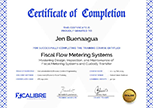| Date | Venue | Fee | |
|---|---|---|---|
| 03 Aug - 07 Aug 2026 | Dubai – UAE | $ 5,950 | Register Now |
| 05 Oct - 09 Oct 2026 | London - UK | $ 5,950 | Register Now |
| 14 Dec - 18 Dec 2026 | Madrid - Spain | $ 5,950 | Register Now |
About the Course
Corrosion remains a major integrity threat for many upstream oil and gas assets. Identifying the associated corrosion damage mechanisms in a timely manner can help the asset owner or operator devise the most appropriate inspection, corrosion rate monitoring, fluid sampling, and, finally, the most relevant and efficient corrosion control and mitigation measures.
This 5-day Corrosion and Corrosion Control in the Upstream Oil and Gas Sector training course is designed to provide a thorough and detailed description of the corrosion damage mechanisms associated with the upstream oil and gas sector, based on internationally-recognised references such as API RP 571 and the UK Energy Institute’s ‘Corrosion Threats Guide for Upstream Oil and Gas Production Plant.’
In addition, this training program is further enhanced by incorporating the latest asset integrity management philosophy and methodology in the form of a corrosion management section. Within this section, both corrosion engineering-based and non-corrosion engineering-based integrity management measures are discussed and covered. Such an approach will enable the delegates to create or (if it already exists) improve their asset integrity management system and render it more efficient in terms of corrosion control and mitigation.
Finally, the content will facilitate corrosion and integrity cost optimisation and simultaneously establish a corrosion failure pre-emption capability for the pertaining assets when the audience applies their newly learned skills by creating new or improving existing asset integrity management systems.
Core Objectives
This training course will teach the delegates the main corrosion damage mechanisms associated with the upstream oil and gas sector and the parameters or factors that control them.
The delegates will achieve the following objectives:
- Learn about the main corrosion damage mechanisms associated with the upstream sector
- Learn about the associated corrosion control measures for each damage mechanism
- Appreciate the pertaining inspection, corrosion rate monitoring, and fluid sampling activities
- Understand how corrosion management differs from corrosion engineering
- Appreciate the significance of non-corrosion engineering parameters in corrosion control
- Learn how to create corrosion control matrices and corrosion key performance indicators
Training Approach
This training course will be done via PowerPoint slides containing text, tables, plots, pictures, etc. The teaching will be interactive; regularly, the delegates will be asked to participate in an ongoing topic, discussion, or challenge. Team exercises will also be presented to the delegates to take part. Past integrity case studies will be presented throughout the daily program to promote best international practices while discouraging integrity practices impairing asset integrity in various projects. It will end with a post-course assessment to help all the delegates remember all the important subjects, concepts, and practices discussed throughout the program.
The Attendees
The training course is intended for anybody whose duties pertain to asset integrity management and corrosion control. There are no technical or academic prerequisites, and anybody with basic knowledge about asset integrity management and corrosion can attend.
Likewise, it will be valuable to the professionals but not limited to the following:
- Corrosion and Integrity Engineers and Managers
- Inspection Engineers
- Maintenance Engineers
- Cathodic Protection and Coating Engineers
- Operation and Production Managers
- Pipeline Integrity Engineers
- Process Engineers
- Health and Safety Engineers
- Chemical Treatment Engineers
- Asset Managers
Daily Discussion
DAY ONE: FROM CORROSION BASICS AND ROOT CAUSES
- Introductions
- Relevant Standards and Codes
- The Corrosion Phenomenon – A Reminder
- Why is Corrosion Still a Major Integrity Threat?
- The Main Root Causes of Upstream Corrosion
- Creating the Integrity Picture
- The Corrosion Engineering Concept
DAY TWO: THE FIRST GROUP OF UPSTREAM CORROSION DAMAGE MECHANISMS
- Estimated Corrosion Costs and Potential Savings
- Upstream Corrosion Damage Mechanisms at a Glance
- Corrosion Under Insulation (CUI)
- Atmospheric Corrosion
- External Corrosion
- Carbon Dioxide Corrosion
- Hydrogen Sulfide Damage Mechanisms (Blistering, HIC, SOHIC and SSC)
DAY THREE: THE SECOND GROUP OF UPSTREAM CORROSION DAMAGE MECHANISMS
- Stress Corrosion Cracking (SCC)
- Oxygen Corrosion
- Erosion Corrosion
- Microbiologically Influenced Corrosion (MIC) – Part I
- Microbiologically Influenced Corrosion (MIC) – Part II
- Stress Corrosion Cracking (SCC)
- Galvanic Corrosion
- Crevice Corrosion
DAY FOUR: THE LAST GROUP OF UPSTREAM CORROSION DAMAGE MECHANISMS AND THE TRADITIONAL INTEGRITY MANAGEMENT (IM) VIEW
- Grooving Corrosion of Pipelines
- Weld Corrosion
- The Traditional Integrity Management (IM) View
- The Traditional Integrity Management (IM) View Shortcomings
- Field Indications of the Traditional Integrity Management (IM) View
- Asset Corrosion Management View Background
- The Three Main International Corrosion Management Models
DAY FIVE: THE CORROSION MANAGEMENT CONCEPT AND APPLICATIONS
- The Morshed Corrosion Management Model (MCMM)
- The Corrosion Management and Integrity Management Measure Concepts
- The Significance of the Integrity Review Process
- Performance Monitoring and Effectiveness Assessment Processes
- The Twelve Management Requirements
- The Role of Communication and Competency
- Corrosion Control Matrices and Corrosion Key Performance Indicators
- Risk-based Inspection
Certificate Awarded
Upon successful completion of this training course, participants will be awarded a Certificate of Completion from XCalibre Training Centre, acknowledging their accomplishment. This certificate serves as a testament to their dedication to developing their skills and advancing their expertise in their respective fields.


